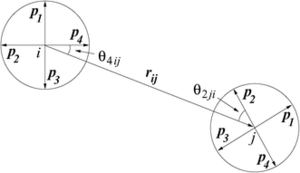Patchy particles: Difference between revisions
Jump to navigation
Jump to search
(New page: The general model for a '''patchy particle''' is given by <ref>[http://dx.doi.org/10.1039/b614955c Jonathan P. K. Doye, Ard A. Louis, I-Chun Lin, Lucy R. Allen, Eva G. Noya, Alex W. Wilber...) |
m (Added stub template.) |
||
| Line 1: | Line 1: | ||
{{stub-general}} | |||
The general model for a '''patchy particle''' is given by | The general model for a '''patchy particle''' is given by | ||
<ref>[http://dx.doi.org/10.1039/b614955c Jonathan P. K. Doye, Ard A. Louis, I-Chun Lin, Lucy R. Allen, Eva G. Noya, Alex W. Wilber, Hoong Chwan Kok and Rosie Lyus "Controlling crystallization and its absence: proteins, colloids and patchy models", Physical Chemistry Chemical Physics '''9''' pp. 2197-2205 (2007)]</ref> | <ref>[http://dx.doi.org/10.1039/b614955c Jonathan P. K. Doye, Ard A. Louis, I-Chun Lin, Lucy R. Allen, Eva G. Noya, Alex W. Wilber, Hoong Chwan Kok and Rosie Lyus "Controlling crystallization and its absence: proteins, colloids and patchy models", Physical Chemistry Chemical Physics '''9''' pp. 2197-2205 (2007)]</ref> | ||
Revision as of 16:14, 9 July 2009
The general model for a patchy particle is given by [1]
where is the Lennard-Jones potential and


